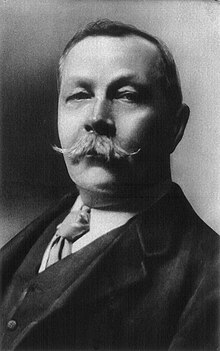About the Book: "A Scandal in Bohemia" was the first of Arthur Conan Doyle's 56 Sherlock Holmes short stories to be published in The Strand Magazine and the first Sherlock Holmes story illustrated by Sidney Paget. (Two of the four Sherlock Holmes novels – A Study in Scarlet and The Sign of the Four – preceded the short story cycle). Doyle ranked A Scandal in Bohemia fifth in his list of his twelve favourite Holmes stories.
It was first published on 25 June 1891 in the issue of the magazine dated July, and was the first of the stories collected in The Adventures of Sherlock Holmes in 1892.
About the Author: Arthur Ignatius Conan Doyle was born on 22 May 1859 at 11 Picardy Place, Edinburgh, Scotland. From 1876 to 1881, he studied medicine at the University of Edinburgh, including a period working in the town of Aston (now a district of Birmingham) and in Sheffield, as well as in Shropshire at Ruyton-XI-Towns. While studying, Doyle began writing short stories. His earliest extant fiction, "The Haunted Grange of Goresthorpe", was unsuccessfully submitted to Blackwood's Magazine. His first published piece "The Mystery of Sasassa Valley", a story set in South Africa, was printed in Chambers's Edinburgh Journal on 6 September 1879. On 20 September 1879, he published his first non-fiction article, "Gelsemium as a Poison" in the British Medical Journal. In 1882 he joined former classmate George Turnavine Budd as his partner at a medical practice in Plymouth, but their relationship proved difficult, and Doyle soon left to set up an independent practice. Arriving in Portsmouth in June of that year with less than £10 (£900 today) to his name, he set up a medical practice at 1 Bush Villas in Elm Grove, Southsea. The practice was initially not very successful. While waiting for patients, Doyle again began writing stories and composed his first novels, The Mystery of Cloomber, not published until 1888, and the unfinished Narrative of John Smith, which would go unpublished until 2011. He amassed a portfolio of short stories including "The Captain of the Pole-Star" and "J. Habakuk Jephson's Statement", both inspired by Doyle's time at sea, the latter of which popularized the mystery of the Mary Celeste and added fictional details such as the perfect condition of the ship (which had actually taken on water by the time it was discovered) and its boats remaining on board (the one boat was in fact missing) that have come to dominate popular accounts of the incident. Doyle struggled to find a publisher for his work. His first significant piece, A Study in Scarlet, was taken by Ward Lock Co. on 20 November 1886, giving Doyle £25 for all rights to the story. The piece appeared later that year in the Beeton's Christmas Annual and received good reviews in The Scotsman and the Glasgow Herald. The story featured the first appearance of Watson and Sherlock Holmes, partially modeled after his former university teacher Joseph Bell. Doyle wrote to him, "It is most certainly to you that I owe Sherlock Holmes ... Round the center of deduction and inference and observation which I have heard you inculcate I have tried to build up a man." Robert Louis Stevenson was able, even in faraway Samoa, to recognize the strong similarity between Joseph Bell and Sherlock Holmes: "My compliments on your very ingenious and very interesting adventures of Sherlock Holmes. ... Can this be my old friend Joe Bell?" Other authors sometimes suggest additional influences—for instance, the famous Edgar Allan Poe character C. Auguste Dupin. A sequel to A Study in Scarlet was commissioned and The Sign of the Four appeared in Lippincott's Magazine in February 1890, under agreement with the Ward Lock company. Doyle felt grievously exploited by Ward Lock as an author new to the publishing world and he left them. Short stories featuring Sherlock Holmes were published in the Strand Magazine. Doyle first began to write for the 'Strand' from his home at 2 Upper Wimpole Street, now marked by a memorial plaque. In this period, however, Holmes was not his sole subject and in 1893, he collaborated with J.M. Barrie on the libretto of Jane Annie. Doyle was found clutching his chest in the hall of Windlesham Manor, his house in Crowborough, East Sussex, on 7 July 1930. He died of a heart attack at the age of 71. His last words were directed toward his wife: "You are wonderful." At the time of his death, there was some controversy concerning his burial place, as he was avowedly not a Christian, considering himself a Spiritualist. He was first buried on 11 July 1930 in Windlesham rose garden. He was later reinterred together with his wife in Minstead churchyard in the New Forest, Hampshire. Carved wooden tablets to his memory and to the memory of his wife are held privately and are inaccessible to the public. That inscription reads, "Blade straight / Steel true / Arthur Conan Doyle / Born May 22nd 1859 / Passed On 7th July 1930." The epitaph on his gravestone in the churchyard reads, in part: "Steel true/Blade straight/Arthur Conan Doyle/Knight/Patriot, Physician, and man of letters". Undershaw, the home near Hindhead, Haslemere, south of London, that Doyle had built and lived in between October 1897 and September 1907, was a hotel and restaurant from 1924 until 2004. It was then bought by a developer and stood empty while conservationists and Doyle fans fought to preserve it. In 2012 the High Court ruled that the redevelopment permission be quashed because proper procedure had not been followed. A statue honours Doyle at Crowborough Cross in Crowborough, where he lived for 23 years. There is also a statue of Sherlock Holmes in Picardy Place, Edinburgh, close to the house where Doyle was born.
My Review: If you enjoy mystery stories and Sherlock Holmes in particular, you will love this short story. The plot is quite interesting: While the currently married Dr. Watson is paying Holmes a visit, a visitor arrives, introducing himself as Count Von Kramm, an agent for a wealthy client. However, Holmes quickly deduces that he is in fact Wilhelm Gottsreich Sigismond von Ormstein, Grand Duke of Cassel-Felstein and the hereditary King of Bohemia. Realizing Holmes has seen through his guise, the King admits this and tears off his mask.
It transpires that the King is to become engaged to Clotilde Lothman von Saxe-Meiningen, a young Scandinavian princess. However, five years previous to the events of the story he had a liaison with an American opera singer, Irene Adler, while she was serving a term as prima donna of the Imperial Opera of Warsaw, who has since then retired to London. Fearful that should the strictly principled family of his fiancée learn of this impropriety, the marriage would be called off, he had sought to regain letters and a photograph of Adler and himself together, which he had sent to her during their relationship as a token. The King's agents have tried to recover the photograph through sometimes forceful means, burglary, stealing her luggage, and waylaying her. An offer to pay for the photograph and letters was also refused. With Adler threatening to send them to his future in-laws, which Von Ormstein presumes is to prevent him marrying any other woman, he makes the incognito visit to Holmes to request his help in locating and obtaining the photograph.
The photograph is described to Holmes as a cabinet (5½ by 4 inches) and therefore too bulky for a lady to carry upon her person. The King gives Holmes £1,000 (£94,300 today[1]) to cover any expenses, while saying that he "would give one of [his] provinces" to have the photograph back. Holmes asks Dr. Watson to join him at 221B Baker Street at 3 o'clock the following afternoon.
The next morning, Holmes goes out to Adler's house, disguised as a drunken out-of-work groom. He discovers from the local stable workers that Adler has a gentleman friend, the lawyer Godfrey Norton of the Inner Temple, who calls at least once a day. On this particular day, Norton comes to visit Adler, and soon afterwards, takes a cab to the Church of St. Monica in Edgware Road. Minutes later, the lady herself gets in her landau, bound for the same place. Holmes follows in a cab and, upon arriving, finds himself dragged into the church to be a witness to Norton and Adler's wedding. Curiously, they go their separate ways after the ceremony.
Meanwhile, Watson has been waiting for Sherlock to arrive, and when Sherlock Holmes finally arrives, he starts laughing. Watson is confused and asks what is so funny, Sherlock then recounts his tale and comments he thought the situation and position he was in at the wedding was amusing. He also asks whether or not Watson is willing to participate in a scheme to figure out where the picture is hidden in Adler's house. Watson agrees, and Holmes changes into another disguise as a clergyman. The duo depart Baker Street for Adler's house.
When Holmes and Watson arrive, a group of jobless men meander throughout the street. When Adler's coach pulls up, Holmes enacts his plan. A fight breaks out between the men on the street over who gets to help Adler. Holmes rushes into the fight to protect Adler, and is seemingly struck and injured. Adler takes him into her sitting room, where Holmes motions for her to have the window opened. As Holmes lifts his hand, Watson recognizes a pre-arranged signal and tosses in a plumber's smoke rocket. While smoke billows out of the building, Watson shouts "FIRE!" and the cry is echoed up and down the street.
Holmes slips out of Adler's house and tells Watson what he saw. As Holmes expected, Adler rushed to get her most precious possession at the cry of "fire"—the photograph of herself and the King. Holmes was able to see that the picture was kept in a recess behind a sliding panel just above the right bell pull. He was unable to steal it at that moment, however, because the coachman was watching him. He explains all this to Watson before being bid good-night by a familiar-sounding youth, who promptly manages to get lost in the crowd.
The following morning, Holmes explains his findings to the King. When Holmes, Watson, and the King arrive at Adler's house, her elderly maidservant informs them that she has hastily departed for the Charing Cross railway station. Holmes quickly goes to the photograph's hiding spot, finding a photo of Irene Adler in an evening dress and a letter dated midnight and addressed to him. In the letter, Adler tells Holmes that he did very well in finding the photograph and fooling her with his disguises. She also reveals that she posed as the youth who bid Holmes good-night. Adler and Norton have fled England, but Adler has promised she keeps the photograph only as protection and not to use it against the King.
The King gushes over how amazing Adler is, saying "Would she not have made an admirable queen? Is it not a pity she was not on my level?" Holmes replies scathingly that Miss Adler is indeed on a much different level from the King (by which he means higher — an implication lost on the King). When he asks Holmes how he wants to be paid, Holmes asks for the photograph of Adler. Holmes keeps it as a souvenir of the cleverness of Irene Adler, and how he was beaten by a woman's wit.
I highly recommend this book to the permanent library of all mystery book lovers. You will not regret reading it!



No comments:
Post a Comment